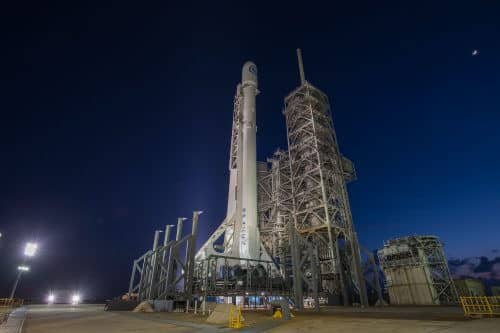The Israeli satellite communications company Chall Communications announced yesterday that its two future satellites, Amos 17 and 8, will be launched by SpaceX's Falcon 9 launchers, whose explosion last year resulted in the destruction of the Amos 6 satellite. Amos 17 will be launched in 2019 free of charge, Possibly using a used Falcon 9 launcher.

Communication space Announced yesterday that it signed a contract with SpaceX to launch the company's two future communication satellites, Amos 17 and Amos 8, in 2019 and 2020 respectively.
According to the company's announcement, Amos 17 will be launched in a three-month launch window in the second quarter of 2019. The payment for the launch of the previous satellite Amos 6, which was destroyed by the explosion of the Falcon launcher on September 9, 2016, will be considered as payment for a loaded shipment 17.
Interestingly, the company said that an Amos 17 launch may be carried out using a Falcon 9 launcher with a used first stage. Although the company will not have to pay for the launch, the announcement hinted that the use of a used launcher would be done in order to advance the satellite's launch date and give it priority in SpaceX's rather busy flight schedule.
Amos 17 will be built for a communications space by the Boeing Company, and its purpose is to replace the Amos 5 satellite, with whom contact was lost in 2015, only four years after its launch in 2011, despite a planned lifespan of 15 years. Amos 17 has a planned mission length of 19 years.
The loss of the two satellites, Amos 5 and 6, resulted in a communication gap to a deep crisis, with only the aging satellite Amos 2 left in its possession, who ended his life in April this year, as well as the Amos 3 and 4 satellites.
In addition to a small fleet of satellites that limits the company's commercial activity, Avi Blasberger, CEO of the Israel Space Agency, warned in an interview with the science website Last year because without using the sky point of the Amos 5 satellite in the geostationary orbit, it may be taken from Israel's hands and returned to the UN for redistribution. A geostationary orbit is an orbit at an altitude of about 36 km, which is ideal for communication satellites because their speed in it is coordinated with that of the Earth's self-rotation, and they are always visible above the same point on the ground. Since only a limited number of satellites can stay in this specific orbit, it is monitored by International Telecommunication Union (ITU) of the United Nations.

Amos 17 is supposed to solve the problem, when it will be launched to a sky point 17 degrees east (hence its name) in a geostationary orbit, which was used by the Amos 5 satellite.
The agreement between Space Communications and SpaceX includes another launch of the Amos 8 satellite, in a three-month launch window "that ends in the second half of 2020", according to the company's announcement.
The cost of launching Amos 8 will be up to about 62 million dollars, the current nominal price of commercial Falcon 9 launchers. Space Communications has not yet announced the identity of the satellite's manufacturer, as recently reported Because similar to Amos 17, it too may be built by a foreign company.
Amos 8 will replace the AsiaSat 8 satellite, which has lost communications Rented part of it at the end of last year, as a replacement for the destroyed Amos 6 as well as a replacement for the Amos 2 satellite that ended its operation this year, and branded it as "Amos 7". Amos 8 will operate at a sky point 4 degrees West in a geostationary orbit (which was used by Amos 2 and is currently used by Amos 3 and Amos 7 / AsiaSat 8).
See more on the subject on the science website:
- Space Communications ordered the "Amos 17" satellite from Boeing for $161 million
- Israeli investment in the field of civil space is the lowest in the world
- Director General of the Ministry of Science Peretz Vezan: The satellite operator must be Israeli owned
- Communication Space: Losing Amos 6 has a material impact on society; Facebook: We will have to do without satellite for now
- Minister of Science Akunis: "The Aerospace Industry will produce one satellite every four years"

One response
I am very sad to see the end of the civilian space industry in Israel. The last project in the pipeline is that of SPACEIL, after which nothing is expected except the developments of the defense space industry. I hope that the private space industry that has developed in the USA will be an inspiration for us and we will see projects that will paint the space blue and white.